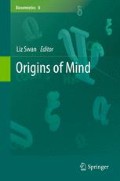Abstract
The Noble Ape Simulation offers an account of the mind as something that can be observed, measured, and ultimately simulated through external effects. This version of the applied mind is not created through a single method but through layering three simulations relating to information chemistry, social constraints, and evolving narrative. As examples, additional simulation elements in Noble Ape are presented to offer the simulation methodology of Noble Ape. This chapter, rather than being a theoretical critique, is intended as a project report relating to three distinct yet interoperating simulated models of the mind. These are presented both as individual simulations and also the simulations’ interactions. This produces a novel account of the applied mind. The methods used in creating such an applied mind provide an interesting insight into the possible origin of mind through pragmatic application rather than conjecture.
Access this chapter
Tax calculation will be finalised at checkout
Purchases are for personal use only
References
Barbalet, T. S. (1997a). The original manuals of Noble Ape. Raleigh: Lulu.
Barbalet, T. S. (1997b). Noble Ape Philosophic. Noble Ape Website. Retrieved February 10, 2012, from http://www.nobleape.com/man/philosophic.html
Barbalet, T. S. (2004). Noble Ape simulation. IEEE Computer Graphics and Applications, 24(2) (pp. 6–12). Los Alamitos: IEEE Computer Society.
Barbalet, T. S. (2005a). Apple’s CHUD tools, Intel and Noble Ape. Noble Ape Website. Retrieved February 10, 2012, from http://www.nobleape.com/docs/on_apple.html
Barbalet, T. S. (2005b). ApeScript notes. Noble Ape Website. Retrieved February 10, 2012, from http://www.nobleape.com/man/apescript_notes.html
Barbalet, T. S. (2009). Noble Ape’s cognitive simulation: From agar to dreaming and beyond. In R. Chiong (Ed.), Nature-inspired informatics for intelligent applications and knowledge discovery: Implications in business, science, and engineering. Hershey: IGI Global Information Science Reference.
Barbalet, T.S., & Stone, H. (2011). Stone Ape Podcast. Retrieved February 10, 2012, from http://www.nobleape.com/stone/
Breazeal, C. L. (2002). Designing sociable robots (Intelligent robotics and autonomous agents). Cambridge, MA: MIT Press.
Dawkins, R. (1987). The blind watchmaker. New York: Norton.
Emmeche, C. (1991). The garden in the machine. Princeton: Princeton University Press.
Kirsh, D. (1991). Today the earwig, tomorrow man? Artificial Intelligence, 47, 161–184.
Hobbes, T. (1651). Leviathan. Retrieved February 10, 2012, from http://archive.org/details/hobbessleviathan00hobbuoft
Langton, C. G. (1997). Artificial life: An overview (Complex adaptive systems). Cambridge, MA: MIT Press.
Levy, S. (1992). Artificial life: A report from the frontier where computers meet biology. New York: Pantheon.
Ray, T. S. (1991). Evolution and optimization of digital organisms. In K. R. Billingsley et al. (Eds.), Scientific excellence in supercomputing: The IBM 1990 contest prize papers (pp. 489–531). Athens: The Baldwin Press.
Shock, J., & Hupp, J. (1982, March). The worms programs – Early experiences with a distributed computation. Communications of the ACM, 25(3), 172–180.
Volterra, V. (1931). Variations and fluctuations of the number of individuals in animal species living together. In R. N. Chapman (Ed.), Animal ecology (pp. 409–448). New York: McGraw-Hill.
Yaeger, L. S. (1994). Computational genetics, physiology, metabolism, neural systems, learning, vision, and behavior or PolyWorld: Life in a new context. In C. Langton (Ed.), Proceedings of the artificial life III conference (pp. 263–298). Reading: Addison-Wesley.
Author information
Authors and Affiliations
Corresponding author
Editor information
Editors and Affiliations
Rights and permissions
Copyright information
© 2013 Springer Science+Business Media Dordrecht
About this chapter
Cite this chapter
Barbalet, T. (2013). The Mind of the Noble Ape in Three Simulations. In: Swan, L. (eds) Origins of Mind. Biosemiotics, vol 8. Springer, Dordrecht. https://doi.org/10.1007/978-94-007-5419-5_20
Download citation
DOI: https://doi.org/10.1007/978-94-007-5419-5_20
Published:
Publisher Name: Springer, Dordrecht
Print ISBN: 978-94-007-5418-8
Online ISBN: 978-94-007-5419-5
eBook Packages: Biomedical and Life SciencesBiomedical and Life Sciences (R0)

